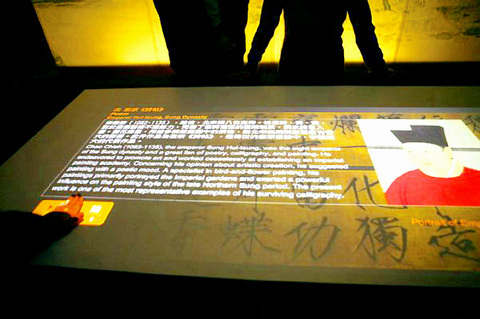The National Palace Museum (
Likewise, artifact exhibits themselves often need to be approached in a new way to appeal to younger generations. Last year the Palace Museum began the laborious challenge of updating its collection, which resulted in an interactive Web site and a series of e-learning DVDs, both of which are geared toward personal use at home or at school.

PHOTO COURTESY OF COURTESY OF TECHART
With the help of a team of graphic designers called TechArt (
The small exhibition is a sample of what is now being accomplished in the art/tech field, said Tuan Li (
"We wanted to do something different from other interactive exhibits. It needed to be innovative," Li said.
The exhibition is divided into two rooms. The first is equipped with six computer monitors, each displaying a different version of the e-learning DVD. The second and more engaging room is designed in the image of a Song Dynasty garden. Antique dressing screens and plants are placed around the room to create a garden feel. All the artwork is in digital form. The explanation of how to use the equipment and the accompanying text to the art pieces are in both English and Chinese.
On one side is a large table monitor that uses a question-and- answer game to provide
information about calligraphy. The lesson focuses on Song Emperor Hui-tsong's (
Moving to the other side of the room, the focus shifts to activities of the nobility during the Song Dynasty incorporating three famous garden paintings. To operate the device, visitors must hold a fan equipped with an infrared sensor to chase away butterflies when they stop on the screen.
While highlighting a painting the interactive board explores various themes in the work, such as the significance of mountains in the landscape painting of Su Han-chen (
The technological features of the exhibition are innovative and the interactive aspect is entertaining. But in terms of its size, there is not a lot to look at. Likewise, if the purpose of the exhibition is to bring art to the people, then it would fare better somewhere more populated, not hidden away in a small room at the back of the CKS museum.
Exhibition notes:
What: National Palace Museum Digital Learning Exhibition
Where: Zhiqing Exhibition Room at the Chiang Kai-shek Memorial Hall Museum, Museum (
Telephone: (02) 2711-1153
When: Until March 27

May 11 to May 18 The original Taichung Railway Station was long thought to have been completely razed. Opening on May 15, 1905, the one-story wooden structure soon outgrew its purpose and was replaced in 1917 by a grandiose, Western-style station. During construction on the third-generation station in 2017, workers discovered the service pit for the original station’s locomotive depot. A year later, a small wooden building on site was determined by historians to be the first stationmaster’s office, built around 1908. With these findings, the Taichung Railway Station Cultural Park now boasts that it has

The latest Formosa poll released at the end of last month shows confidence in President William Lai (賴清德) plunged 8.1 percent, while satisfaction with the Lai administration fared worse with a drop of 8.5 percent. Those lacking confidence in Lai jumped by 6 percent and dissatisfaction in his administration spiked up 6.7 percent. Confidence in Lai is still strong at 48.6 percent, compared to 43 percent lacking confidence — but this is his worst result overall since he took office. For the first time, dissatisfaction with his administration surpassed satisfaction, 47.3 to 47.1 percent. Though statistically a tie, for most

Wooden houses wedged between concrete, crumbling brick facades with roofs gaping to the sky, and tiled art deco buildings down narrow alleyways: Taichung Central District’s (中區) aging architecture reveals both the allure and reality of the old downtown. From Indigenous settlement to capital under Qing Dynasty rule through to Japanese colonization, Taichung’s Central District holds a long and layered history. The bygone beauty of its streets once earned it the nickname “Little Kyoto.” Since the late eighties, however, the shifting of economic and government centers westward signaled a gradual decline in the area’s evolving fortunes. With the regeneration of the once

In February of this year the Taipei Times reported on the visit of Lienchiang County Commissioner Wang Chung-ming (王忠銘) of the Chinese Nationalist Party (KMT) and a delegation to a lantern festival in Fuzhou’s Mawei District in Fujian Province. “Today, Mawei and Matsu jointly marked the lantern festival,” Wang was quoted as saying, adding that both sides “being of one people,” is a cause for joy. Wang was passing around a common claim of officials of the People’s Republic of China (PRC) and the PRC’s allies and supporters in Taiwan — KMT and the Taiwan People’s Party — and elsewhere: Taiwan and